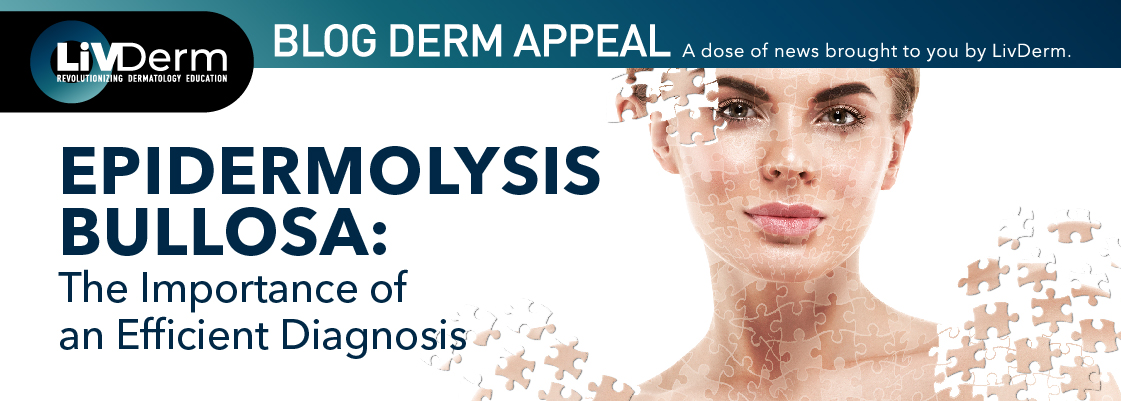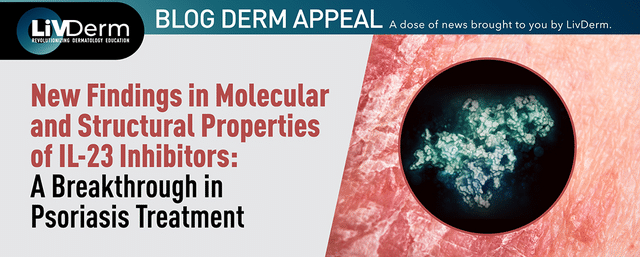What is EB?
Dermatologists know that Epidermolysis Bullosa (EB), is a family of rare genetic disorders characterized by blistering and fragility of the skin and mucous membranes that can affect the mouth, esophagus, lungs, nails, and other areas of the body. This serious condition requires efficient diagnosis but sadly, there is currently no known cure. Due to the rates of misdiagnosis, the large care teams that are involved in treating these patients (many times from infancy) and some positive updates in the EB world, LiVDerm believes EB to be an important topic to explore in order to keep health care providers in the know.
There are four types of EB and some of these are more common than others. Each type reflects the underlying gene mutation and where on the body the blistering occurs as well as which layer of the skin is affected.
Epidermolysis Bullosa Complex (EBS)
This is the most common form of the disease, affecting over 70% of patients. It is considered a major form of EBS caused by mutation in the genes KRT5 and KRT14. These genes are responsible for the creation of proteins keratin 5 and keratin 14 respectively. For many individuals with mild EBS, blisters usually heal without scarring. However, in more extreme cases, blistering may be more widespread and lead to infections, dehydration and other medical conditions.
Junctional Epidermolysis Bullosa (JEB)
In approximately 5% of patients, JEB affects the lamina lucida skin layer. In many cases, blistering occurs on the skin as well as inside the body. This variation is caused by the mutation of the LAMA3, LAMB3, or LAMC3 genes, which are responsible for the protein laminin 332 and the gene COL17A1, which holds instructions for the production of collagen 17. When blistering occurs inside the body, such as in the mouth and esophagus, it can make eating and swallowing difficult, leading to slower growth and numerous other medical conditions. Furthermore, fusion of fingers and toes, nail abnormalities and contractures are also common with this form of the disease.
Dystrophic Epidermolysis Bullosa (DEB)
This form of EB is caused by the mutation of the gene COL7A1, which is responsible for the production of collagen VII, the protein required for anchoring fibrils that maintain cohesion between the epidermis and dermis. It occurs in approximately 25% of patients. In mild cases, blistering may occur on the hands, feet, knees and elbows. However, more severe cases can also cause more widespread blistering of the skin as well as inside the body, which can lead to additional, serious medical conditions. Because it is believed to pose a higher risk for serious complications, individuals diagnosed with DEB require vigilant monitoring for possible internal and external complications. Furthermore, individuals with recessive DEB (RDEB) are also at increased risk of developing squamous cell carcinoma.
Kindler Epidermolysis Bullosa (KEB)
Also known as Kindler Syndrome, KEB is a very rare type of EB, affecting less than 1% of patients. It is caused by a mutation of the gene, FERMT-1, responsible for protein kindlin-1. Along with the blistering of areas of the skin typical with all forms of EB, KEB can also affect the inside of the body, including the mouth, eyes, intestines, esophagus, genitals, and urinary system. The occurrence of any additional conditions can undoubtedly lead to further severe health complications.
Complications of EB Diagnosis
EB is believed to affect approximately 500,000 people around the world, and one out of every 20,000 births in the United States. The fact that it is such a rare disorder means oftentimes it is hugely misdiagnosed. An improper diagnosis may subsequently lead to a deficiency in appropriate care and treatment of the patient.
There are currently three methods used for the diagnosis of EB: examining the symptoms, conducting a biopsy, or undergoing genetic testing.
The problem that arises from diagnosing the type of EB from a simple examination of the symptoms lies with the fact that the symptoms for each type of EB typically overlap to a great extent. And with there being four major types of EB as well as a number of further subtypes, this makes coming to a precise diagnosis exceedingly challenging. Furthermore, EB also shares a variety of symptoms with other non-EB blistering skin conditions. Consequently, there is no way to conclusively diagnose EB type from symptom checking alone.
Biopsies, although a more reliable option than simply examining the symptoms, may still not always provide a definite diagnosis. Again, the existing myriad of subtypes that are present with EB do not always allow for an absolute determination.
Genetic testing for EB is regarded as the best and most accurate option for diagnosing the type. A simple analysis of blood or saliva can pinpoint the type of EB, thus providing for more efficient and appropriate management of the disorder.
The Importance of an Accurate Diagnosis
Providing individuals with an accurate EB diagnosis is a crucial element in patient care. Being burdened with this painful disorder is in itself not just challenging but physically and mentally exhausting. Patients come to greatly rely on their caregivers to help them manage their symptoms as well as provide them with useful information and guidelines in living and coping with the disease. Regrettably, with there being no cure, the only option for EB currently, is a carefully managed plan designed to cater to the specific symptoms of the particular EB type. That being said, it is only by a conclusive diagnosis that a tailored care plan can be put into effect. Furthermore, aside from the symptoms itself, caregivers and providers must also carefully weigh the unique situation of the patient.
Due to the fact that EB can give rise to a number of other serious medical conditions, further complicating this distressing disease, it is important to know which type of EB is present. Some complications may be more probable than others and it is essential to find the right balance between managing the symptoms and the right preventative care options for any additional risk factors.
A conclusive diagnosis may also be considered an essential aspect when it comes to family planning. Couples with a history of the disorder may largely benefit from knowing the likelihood of their children being born with the same mutated genes. A pre-existing awareness of this allows for careful consideration of any future pregnancies.
Another important aspect which may often be overlooked is patient peace of mind. As with many other physical disorders, a person’s mental health may suffer enormously. Patients with debilitating and disfiguring physical illnesses are more prone to suffer from depression, anxiety and suicidal tendencies. Knowing precisely the type of disorder they suffer from can help them to firstly, learn more about and understand the impacts and future risk factors. Secondly, it can allow them to better connect with others who suffer from the same condition, affording them comfort in like minded friends who can offer support not available from others who may not fully understand them.
Ultimately, an accurate diagnosis is beneficial on a number of levels. Not only does it allow for a more dedicated, targeted surveillance plan, but also precision medication and the possibility of taking part in future clinical trials.
Genetics Testing as the Way Forward
According to DEBRA International Clinical Practice Guidelines, genetic testing is always recommended for the diagnosis of EB.
“The pathogenic sequence variants will provide clarity for the definitive diagnosis, prognosis and inheritance for the patient with EB and their family, and their identification is therefore essential. Moreover, it is the basis for the risk calculation of having affected offspring in the same generation by the same biological parents of the proband, and of his or her offspring being affected. Furthermore, it provides the basis for genetic prenatal or preimplantation diagnosis in subsequent pregnancies.” – Clinical Practice Guidelines for Laboratory Diagnosis of EB, C. Has et al.
Despite this, only 56% of patients with EB have had genetic testing to confirm EB type. For many people, cost constraints are a large contributing factor to not coming forward for testing. The good news is that there is now an opportunity for eligible individuals to have these genetic tests carried out at no cost. Patients are eligible if they have symptoms consistent with EB, have never had prior genetic testing for EB and are residents of the U.S. or Puerto Rico. These tests involve a simple blood or buccal sample to be collected and subsequently analyzed.
For many individuals, this opportunity could be life-changing as it can provide more than just peace of mind and a conclusive diagnosis. It can additionally afford both patients and their caregivers to develop a well-balanced unique symptom management plan for improved patient care.
Key takeaway
For many individuals living with EB, their lives are full of uncertainties, but not knowing what type of EB they have does not have to be one of them. Genetic testing for EB can provide a complete and accurate diagnosis for the patient so they are able to move forward with appropriate care and treatment options with their health care provider. Patients are encouraged to speak with their doctor to learn more about genetic testing and for more information on a FREE genetic test, visit the GeneDx website.
- https://www.debra-international.org/eb-health-care-cpgs
- https://www.debra.org/about-eb/eb-depth
- https://www.ebresearch.org/what-is-eb.html
- https://debfacts.com/accurate-diagnosis-matters/
- https://med.stanford.edu/dermatology/resources/gsdc/eb_clinic/eb-faqs.html#:~:text=Based%20on%20statistics%20collected%20through,the%20United%20States%20have%20EB.
- https://debfacts.com/hcp/testing-for-deb/
- https://medlineplus.gov/genetics/condition/dystrophic-epidermolysis-bullosa/#causes
- GeneDx | Sponsored testing program by Krystal Decode DEB | GeneDx
- https://debfacts.com/recognizing-deb/
- https://af13d689-15eb-4199-8733-e91a7bb8ae3f.usrfiles.com/ugd/af13d6_47c0d453177b4a07928c9a0e45969f96.pdf
















